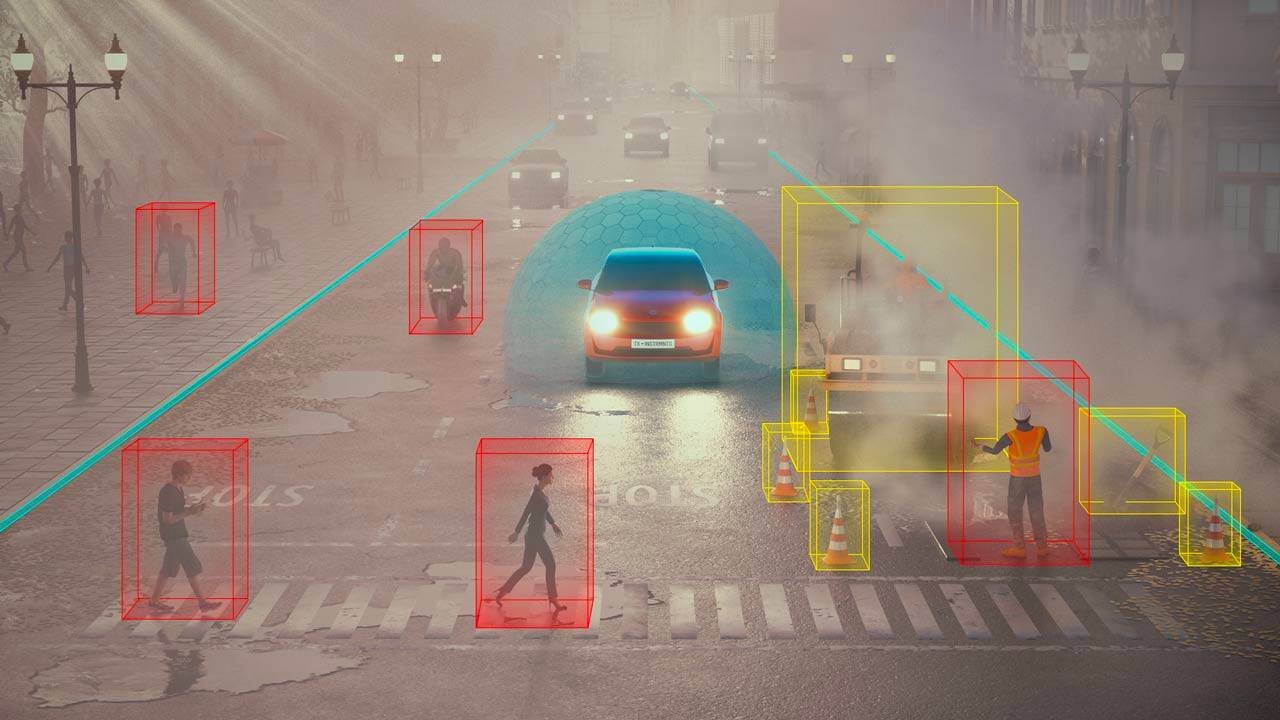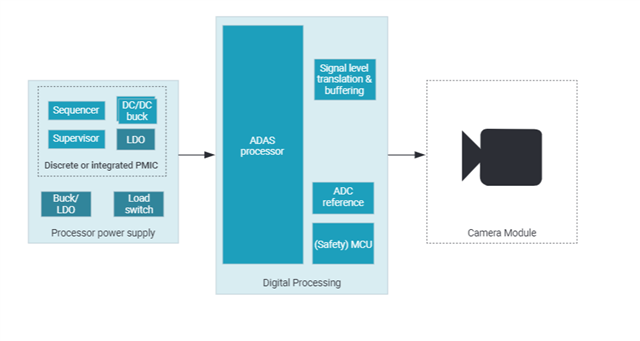SSZTD06 November 2023 LMQ644A2-Q1 , TDA4AL-Q1 , TPS6593-Q1 , TPS6594-Q1
Front camera units are an essential component of advanced driver assistance systems (ADAS), especially now that New Car Assessment Program requirements include automatic emergency braking and front collision avoidance as standard features. Front cameras help with other ADAS features such as adaptive cruise control, pedestrian detection, lane-keeping assistance and traffic sign recognition.
In Figure 1, you can see an example of how cameras can be used for object detection to enable ADAS features.
 Figure 1 Real-time processing using
cameras
Figure 1 Real-time processing using
camerasIn order to perform processing tasks like vision pre-processing, depth and motion acceleration or AI network processing to support ADAS functions, the system-on-a-chip (SoC) in the system needs an efficient power supply. There are four major power-supply challenges when designing ADAS front cameras.
Challenge No. 1: Small solution size
A front camera’s location on the windshield places strict requirements on size. The camera module can include one camera or two: one for a wider field of view or higher resolution, and a second for longer ranges.
While the majority of the market uses single-camera modules, dual-camera modules are becoming more popular in order to obtain a better view of a vehicle’s surroundings and achieve increasing levels of autonomy. High-resolution and higher-frame-rate camera modules are trends as well. While the performance of the camera increases, camera modules themselves are shrinking, with a typical size of 18 mm by 18 mm.
Remote camera modules use serializer-deserializer (SerDes) links to transmit data from the camera module to the ECU. The front camera module’s co-location to the front camera ECU sends the data to the ECU board using Camera Serial Interface (CSI)-2. The camera module input supply in a front camera can be as low as 5 V, while power-over-coaxial cable remote camera modules are typically 9 V. The multichannel power-management IC (PMIC) on the front camera module daughter board is a low-voltage input capable of supplying power to the imager and any additional processing that occurs on the camera module. Processing is done by using the onboard microcontroller (MCU) before streaming data to the ECU using CSI-2. The MCU on the camera module could perform image signal processing at the pixel level, or a stand-alone chip could handle it. There are no rails needed to power the SerDes chipsets usually found in remote camera modules. A low-voltage PMIC with the right number of rails to power the image sensor and other peripherals on the camera module can help achieve the small spaces that these systems require.
Figure 2 shows a high-level block diagram of a front camera system, typically located behind the windshield close to the rearview mirror, comprising a front camera electronic control unit (ECU) that does the processing and a camera module that houses the image sensor.
 Figure 2 Front camera system block diagram
Figure 2 Front camera system block diagramThe vision processors used in front camera applications have dedicated hardware accelerators called vision processing accelerators and depth and motion perception accelerators to detect objects at the edge. In addition, these processors may have artificial intelligence (AI) capabilities, with a dedicated matrix multiplying accelerator to help with deep learning. Given this amount of processing, the PMIC must be able to meet the current requirements of the processor without increasing solution size.
A PMIC should have excellent transient response to meet the load transient requirements of the AI processor, with minimal output capacitance to keep solution size small. Integrating the buck regulator, low-dropout regulators, load switches, voltage monitors, sequencers, watchdog timers, error signaling modules and additional general-purpose input/outputs helps achieve a small size, especially compared to a discrete approach with multiple components that increase overall solution size and cost.
The popular power tree architecture in this application is to create a two-stage power conversion, which helps to maintain total efficiency and keeps component temperatures within the acceptable range. In this power tree architecture, the front-stage DC/DC steps down the 12 V battery voltage to a regulated intermediate voltage (for example, 5 V or 9 V) to the multichannel PMICs. The front-stage DC/DC should be a Wide-VIN buck converter, supports the transients of the 12 V battery voltage dips down to 3 V and surges up to 36 V.
Challenge No. 2: Functional safety
Because automatic emergency braking and adaptive cruise control involve front cameras, functional safety becomes extremely important. The front camera system often has an Automotive Safety Integrity Level (ASIL) B requirement, which means that the PMIC supply to the processor has to be able to meet ASIL B requirements in order to help achieve overall system-level functional safety requirements.
Here are just some of the features that you can expect in an ASIL B PMIC:
- Voltage monitors for the PMIC rails.
- Additional monitors to detect other rails in the system.
- Bandgap redundancy.
- A watchdog timer for detecting software faults.
- An error signaling monitor for detecting hardware faults.
Challenge No. 3: Low cost
The low-cost requirements of the system are driven primarily by the high-volume adoption of front cameras in passenger and light commercial vehicles. With projected volumes north of 70 million units by 2028, front camera systems are one of the most common ADAS applications in the vehicle.
High volumes place cost pressures on tier-1 supplier and thus on semiconductor suppliers. It is possible to keep the overall system costs low by reducing bill-of-materials count, selecting integrated components, choosing the right technology node, and keeping silicon costs low. A PMIC provides small size and integrates multiple power components to help achieve these benefits and optimize costs.
Challenge No. 4: Thermal Performance
The front camera’s location on a vehicle windshield means that it will be exposed to heat under normal operating conditions. Heat contributes to thermal noise and causes poor image quality, especially in low light conditions. The need for a small printed circuit board area for the front camera and the heating of the camera in the camera module additionally increase the thermal challenges of this application. It is crucial for the system to optimize thermal performance in order to operate in various conditions. The PMIC's thermal performance can help keep the circuit board at a low temperature.
Conclusion
Adding a PMIC on an ADAS front camera can mitigate the four challenges I’ve described here and enhance power and thermal efficiency in the front camera systems. The AM62A-Q1 or TDA4AL-Q1 processor families might be the right fit to simplify your front camera design process, depending on your system requirements.
Additional resources
- Check out the TPS6594-Q1 and TPS6593-Q1 product pages.
- Read more about our scalable processors for ADAS domain controllers.
- Learn more about Wide VIN scalable buck regulator design for ADAS using LMQ644A2-Q1.